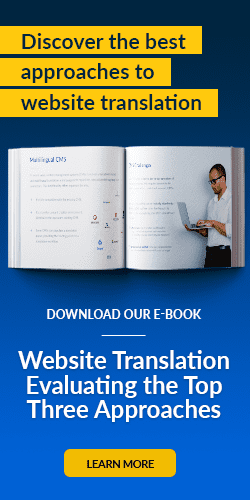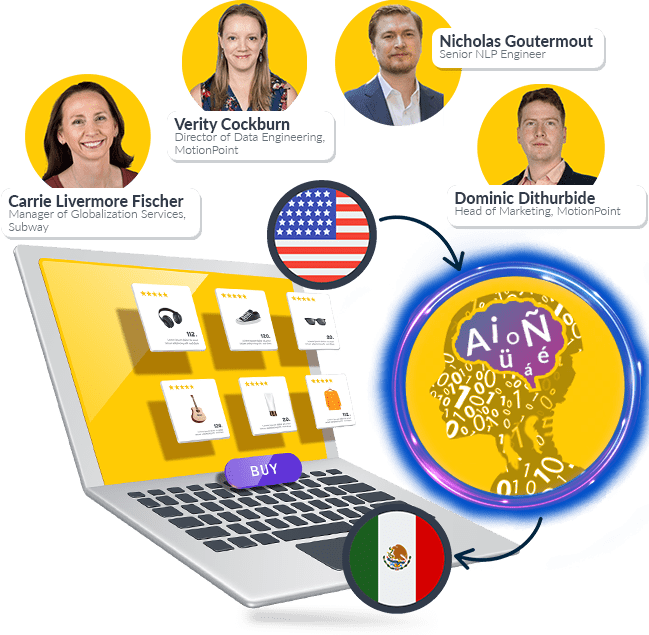Due to a lack of expertise, insight and proper technologies, traditional translation agencies can't adapt to the unique demands of website translation. Those shortcomings result in:
- Poor presentation of on-site content, resulting in bad UX
- Inefficient or inflexible workflows that create expense effort for you and your team
- An inability to maximise the value of your translation investments
Read on to discover how the technologies and experience that a digital-first agency provides can mitigate these costly challenges.
In-Context Translations
Most traditional translation agencies use aged manual processes that may be fine for offline and document translation projects, but they fall far short of what’s needed for website translation.
For instance, document translation projects do not require a highly iterative "live view" QA process. Website translation projects do.
Digital-first agencies have the right technologies to deliver great in-context translations. Legacy agencies don't.
Linguists must have full visibility into how content "fits" on a webpage's template. This enables them to modify lengthy translations that might break page templates. They also need to see how the content they're localising is informed by other on-page elements such as images and dynamically-loaded content. Some of those elements, including images, may require translation, too.
Digital-first agencies that specialize in fully turn-key website translation solutions have the tools and visibility to handle these tasks. Legacy agencies don't.
Superior Flexible Process
As your website translation project unfolds, you'll determine there are some localisation tasks that you'll want to oversee, and many you won't. (For instance, vetting localised legal or regulatory content is important, but reviewing translated product info isn't.)
You need an agency that accommodates such customised workflows. Traditional agencies don't often do that. They try to squeeze translation tasks into an either/or workflow, which is inflexible, inefficient and can cause problems.
Focus on what's most important to your business. Reviewing endless localised content shouldn't be a part of that.
Digital-first agencies do things differently. You can tell these vendors the specific content you wish to review, and they'll provide it. They handle translating and publishing the rest, with no effort from your team.
This empowers you to focus on what's most important to the organisation without being burdened with everlasting demands to review content.
Localisation and Customisation
It's not enough to simply publish your website in a customer's preferred language. It's critical to provide culturally-authentic, highly relevant translations, too.
These region-specific localizations, which feature local lingo and other cultural references, can really improve on-site engagement and conversion rates.
Customising content and messaging is great for business. Digital-first agencies excel at creating this online content for you.
Legacy agencies might have this linguistic and cultural knowledge, but they rarely have the technical expertise to reliably publish this content on your website. The task requires an authoritative fluency in online technologies, applications and code that most linguists were never trained for, and will never have.
Digital-first agencies specialize in these technologies, and can easily implement these brand- and business-boosting content optimizations.
Confirmed Specialization
Traditional agencies excel at translating printed content and other offline material. But digital-first agencies can do that, and go much further.
Your existing translations—everything your company has ever translated that might be stored in a translation memory database—can be re-used for publication on your website, and vice versa. This maximises the value of your existing translation investment.
Digital-first agencies also create resources such as glossaries and style guides to ensure consistent translations and brand voice across your website and multichannel assets.
On-Site UX and Translation Quality
The responsibility of ensuring the quality of on-site translations should fall to your agency, not you. But that's not how most legacy agencies operate.
Recall that these agencies don't have the "live view" tools needed to accurately QA how their translations visually appear, or are interpreted, on a webpage. This creates big problems that impact UX and alienate users.
These agencies typically require their customers-that means you-to assume the iterative process of finding those gaps and repeating the revision process until the agency gets it right. That's a huge drain on your time and resources.
A technically deficient legacy agency will depend on you to make its job easier. Turn-key digital agencies eliminate your effort.
Further, legacy agencies often lack the ability to accurately parse translatable content for unique web components and experiences.
For instance: Your website may use a single-page AngularJS application that changes on-the-fly, depending on a user's on-site behavior. Does your traditional translation agency even know where to look for that translatable content?
It’s unlikely. This means the cumbersome and time-consuming burden of identifying this content falls to you and your team.
Conclusion
Website translation requires the expertise of a technology-savvy digital-first agency. As you examine the capabilities of your current translation agency, ask yourself:
- Do they focus on content that enhances the user experience?
- Can they customise workflows to minimise my involvement, but give me control when I need it?
- Do they have the technical expertise to customise on-site content for specific markets or regions?
- Do their technologies and processes eliminate operational complexity and effort for my team?
If not, consider looking for digital-first agencies that have the web-centric tools and expertise to deliver the best-in-breed localised websites you'll need for international success.
Last updated on October 25, 2017


